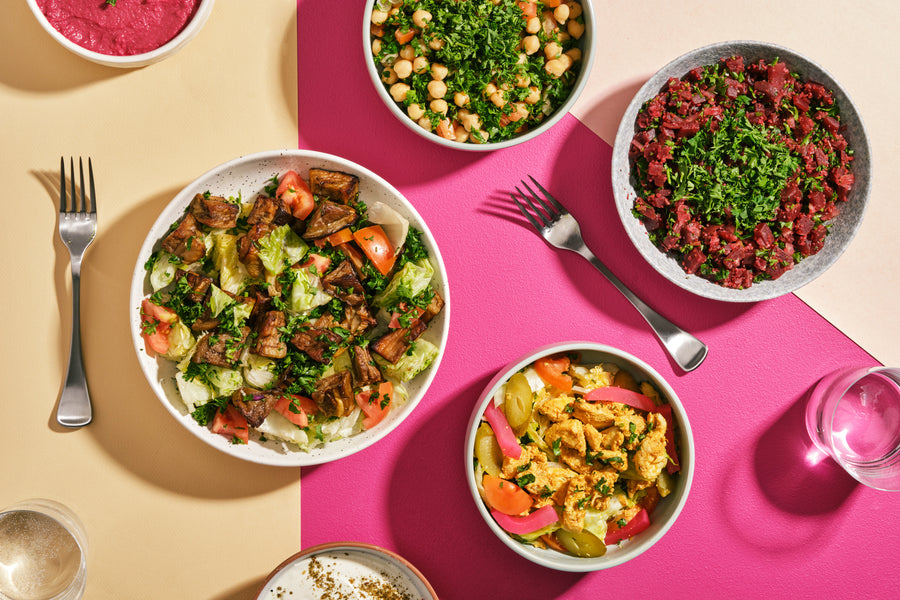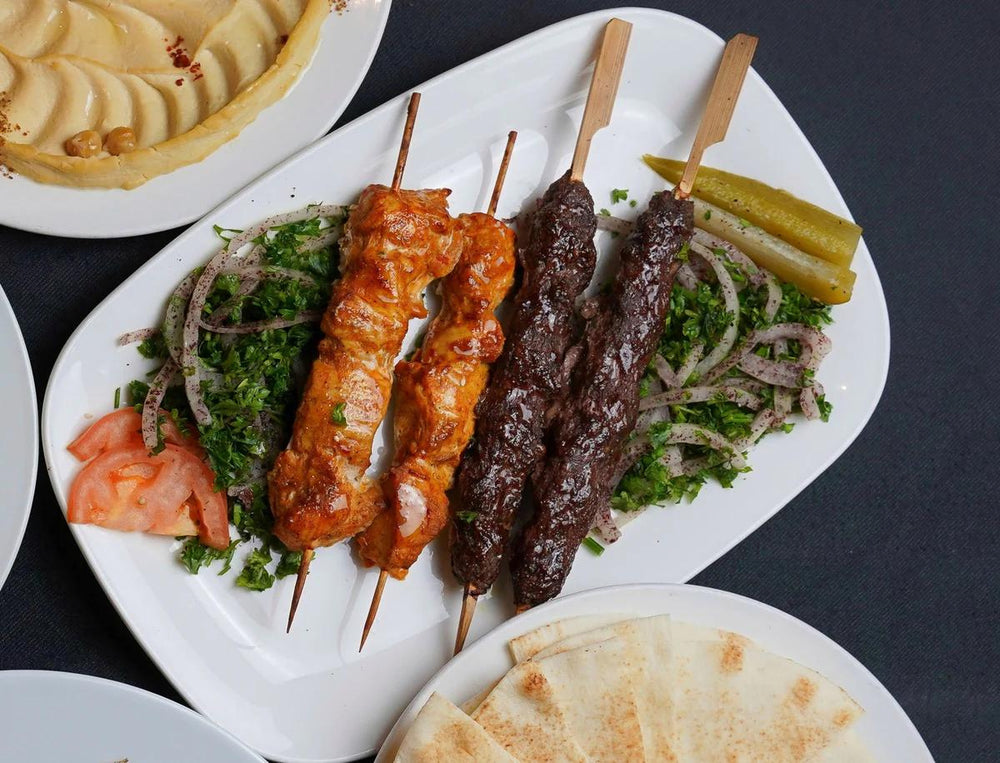A Deep Dive Into Syrian Food: Comprehending Its Cultural Significance and Halal Facets
Syrian food personifies an abundant tapestry of historical narratives and cultural impacts. Each recipe narrates of area and custom, stressing the value of shared meals. The adherence to halal techniques not only mirrors faiths but also shapes the identification of Syrian food preparation. As international events test these culinary practices, the strength of this food stays a prime focus of social conservation. What exists behind the tastes that specify this enduring heritage?
The Historical Roots of Syrian Food
Although Syrian cuisine has advanced over centuries, its historical roots are deeply intertwined with the region's diverse social impacts. Situated at the crossroads of different human beings, Syria has absorbed culinary practices from the Phoenicians, Greeks, Romans, and Ottomans, to name a few. This rich tapestry of background has actually added to a cuisine identified by a blend of flavors, seasonings, and food preparation techniques. The abundant lands of the region have likewise played an important duty, supplying a wealth of grains, fruits, and veggies that develop the structure of numerous dishes. The introduction of new ingredients through profession and occupation additionally improved the cooking landscape, permitting the advancement of distinct local specialties. Additionally, the influence of surrounding nations has resulted in a dynamic exchange of culinary ideas, solidifying Syria's placement as a substantial gamer in the wider context of Center Eastern gastronomy.

Standard Syrian Meals and Their Cultural Significance
Standard Syrian dishes are not just culinary staples yet likewise bring deep social significance, reflecting the country's rich heritage. Iconic dishes, frequently prepared during festive occasions, offer as a way of uniting family members and communities. These dishes personify the tastes of Syria while enhancing social bonds through shared celebrations and customs.
Iconic Syrian Staples
When exploring the abundant tapestry of Syrian food, one discovers a range of famous meals that not just tantalize the taste buds however likewise symbolize the nation's social heritage. Amongst these staples, Kabsa attracts attention as a great smelling rice dish, commonly experienced with spices like saffron and cardamom, signifying friendliness. Fattoush, a lively salad made with combined greens and crunchy bread, shows the significance of fresh ingredients in Syrian cooking. Muhammara, a spicy dip made from peppers and walnuts, showcases the abundant flavors particular of the area. In addition, Kibbeh, a recipe made from bulgur and minced meat, is frequently considered a national prize, standing for public gatherings. Each meal narrates, linking individuals to their practices and roots.
Festive Meal Traditions
Syrian cheery dish practices are rich with symbolism and significance, as family members gather to commemorate vital occasions through the sharing of beloved recipes. Dishes usually showcase an array of standard foods, with dishes like kibbeh, mansaf, and tabbouleh taking center phase. Each dish lugs social background; as an example, kibbeh, made from bulgur and minced meat, stands for hospitality and wealth. Throughout Ramadan and Eid, family members prepare unique sweets such as maamoul, signifying happiness and unity. These celebrations foster neighborhood bonds, as sharing a meal indicates love and togetherness. The prep work and pleasure of these meals show Syria's diverse cooking heritage, intertwining family members customs and local impacts, consequently enriching the festive experience and protecting cultural identification.
The Role of Household and Area in Syrian Food Culture
Food works as a vital string that weaves together family members and community in Syrian culture. Dishes are usually common experiences, where family members collect around a table to share traditional dishes that show their heritage. The prep work of food is a public task, with generations functioning side by side, passing down dishes and food preparation strategies. This practice strengthens domestic bonds and promotes a sense of belonging within the community.Special celebrations and religious parties even more highlight the relevance of food in Syrian society. Throughout these events, families prepare elaborate meals that serve not just to nourish yet additionally to share love and hospitality. The act of sharing food symbolizes unity and support amongst next-door neighbors and friends, enhancing social ties. Through these shared cooking experiences, Syrians cultivate a solid identity rooted in their abundant social history, showing just how food goes beyond mere nutrition to come to be an essential component of their social fabric.
Halal Practices in Syrian Cooking
In the context of public meals and family members celebrations, halal practices play a considerable function in Syrian food preparation. These techniques come from Islamic dietary legislations, making sure that food is prepared and eaten in a way that aligns with faiths. For numerous Syrian family members, adherence to halal concepts affects different elements of dish preparation, from sourcing active ingredients to cooking methods.Animals used for meat has to be butchered according to specific standards, emphasizing gentle therapy and invoking the name of Allah. Furthermore, cross-contamination with non-halal products is thoroughly avoided in both home kitchen areas and industrial establishments.This dedication to halal not only shows spiritual devotion but also fosters a feeling of neighborhood, as family members usually integrated to share meals that recognize these customs - Brunch Kitsilano Vancouver BC. Halal practices are deeply woven right into the fabric of Syrian culinary society, shaping both day-to-day life and festive occasions.
Active Ingredients That Specify Syrian Tastes

The significance of Syrian cuisine is formed by an unified blend of key spices and herbs that enhance its distinct tastes. Standard cooking techniques additionally boost these components, showcasing the abundant culinary heritage of the area. An overview of necessary active ingredients exposes the foundational function they play in producing genuine Syrian meals.
Key Flavors and Herbs
A lively tapestry of flavors defines Syrian cuisine, with crucial spices and herbs playing a necessary function in specifying its essence. Popular among these are cumin, coriander, and sumac, which provide you can try here deepness and warmth to different dishes. Cumin, with its nutty scent, usually improves stews and barbequed meats, while coriander includes a citrusy note to salads and dips. Sumac, recognized for its tangy flavor, brightens dishes and is often sprinkled over fattoush or kebabs. Furthermore, cinnamon and allspice supply a refined sweet taste, frequently located in both pleasant and full-flavored prep work. Fresh natural herbs like dill, mint, and parsley are additionally important, providing a burst of quality and stabilizing the abundant, complicated flavors that make Syrian food one-of-a-kind.
Traditional Food Preparation Methods
Cooking methods in Syrian food mirror a deep-rooted practice that boosts the flavors of its active ingredients. Approaches such as slow-cooking and braising are commonly used, permitting herbs and spices to blend beautifully with meats and vegetables. Barbecuing, specifically over charcoal, imparts a smoky richness to meals like kebabs, while steaming is often used for rice, maintaining its appearance and taste. Furthermore, sautéing Continue is favored for preparing aromatic bases, commonly starting with onions and garlic to develop depth. Fermentation contributes in creating unique tastes, obvious in meals like pickled vegetables. These methods not only highlight the top quality of active ingredients however likewise embody the communal spirit of food preparation, bringing families together around shared dishes steeped in custom.
Necessary Ingredients Overview
While checking out Syrian cuisine, one quickly discovers that essential ingredients play a crucial role in defining its unique tastes. Olive oil, a staple, supplies richness and depth, commonly acting as a base for numerous recipes. Fresh natural herbs, such as parsley, mint, and cilantro, add dynamic fragrances and preferences, improving the total experience (Brunch Kitsilano Vancouver BC). Seasonings like cumin, coriander, and cinnamon are often used, adding heat and complexity to dishes. In addition, Syrian food heavily integrates grains, particularly bulgur and rice, which work as essential elements in numerous recipes. Pulses, especially chickpeas and lentils, supply both nourishment and appearance. With each other, these ingredients create the harmonious equilibrium that defines Syrian dishes, showing the nation's rich cooking heritage and social importance
The Influence of Battle on Syrian Cooking Customs
The battle in Syria has functioned destruction across the country, its impact on culinary traditions discloses a complicated interaction of resilience and adaptation. As areas encountered displacement, conventional dishes were customized due to the shortage of components and resources. Family members frequently depend on in your area available fruit and vegetables, incorporating new flavors and methods into their meals, which resulted in the appearance of distinct analyses of classic dishes.Moreover, the war promoted a spirit of uniformity amongst displaced cooks and home cooks, who shared their culinary understanding through social media sites and neighborhood kitchen areas. This sharing of recipes not just additional resources maintained cultural heritage yet also produced a feeling of belonging among those impacted by the problem. Regardless of the hardships, the interest for food stays a unifying pressure, permitting people to preserve their identity and attach with their origins, even in exile. Subsequently, Syrian cuisine continues to evolve amid adversity, mirroring both an abundant history and contemporary durability.
Frequently Asked Inquiries
What Are Common Food Preparation Strategies Made Use Of in Syrian Cuisine?
Common cooking strategies in Syrian food consist of barbecuing, cooking, sautéing, and cooking. These approaches boost flavors and structures, enabling the development of diverse meals that reflect the area's abundant cooking heritage and customs.
Exactly How Has Globalization Influenced Syrian Food?

Are There Vegetarian Options in Standard Syrian Recipes?
Vegan choices are common in conventional Syrian recipes, including ingredients like veggies, lentils, and chickpeas. Popular meals such as Mujadara and Falafel highlight this variety, fitting different dietary choices while protecting the abundant flavors of the food.
What Beverages Pair Well With Syrian Meals?
Beverages that combine well with Syrian meals consist of mint tea, pomegranate juice, and ayran - Brunch Kitsilano Vancouver BC. These beverages match the tastes of traditional recipes, improving the dining experience while supplying invigorating contrasts to the rich, full-flavored preferences
How Do Syrians Celebrate Food Throughout Holidays or Festivals?
Syrians celebrate food during holidays and festivals with elaborate banquets, often including conventional recipes. Household celebrations emphasize sharing dishes, symbolizing unity and social heritage, while special deals with and sweets highlight the joyful spirit and communal joy. Standard Syrian recipes are not just cooking staples but also bring deep social relevance, showing the nation's abundant heritage. When discovering the abundant tapestry of Syrian cuisine, one discovers a selection of famous dishes that not only entice the taste but also symbolize the nation's social heritage. Syrian cheery meal practices are abundant with meaning and value, as family members collect to commemorate essential celebrations via the sharing of cherished recipes. Cooking methods in Syrian food mirror an ingrained custom that enhances the tastes of its ingredients. Vegan alternatives are common in conventional Syrian meals, including ingredients like chickpeas, veggies, and lentils.